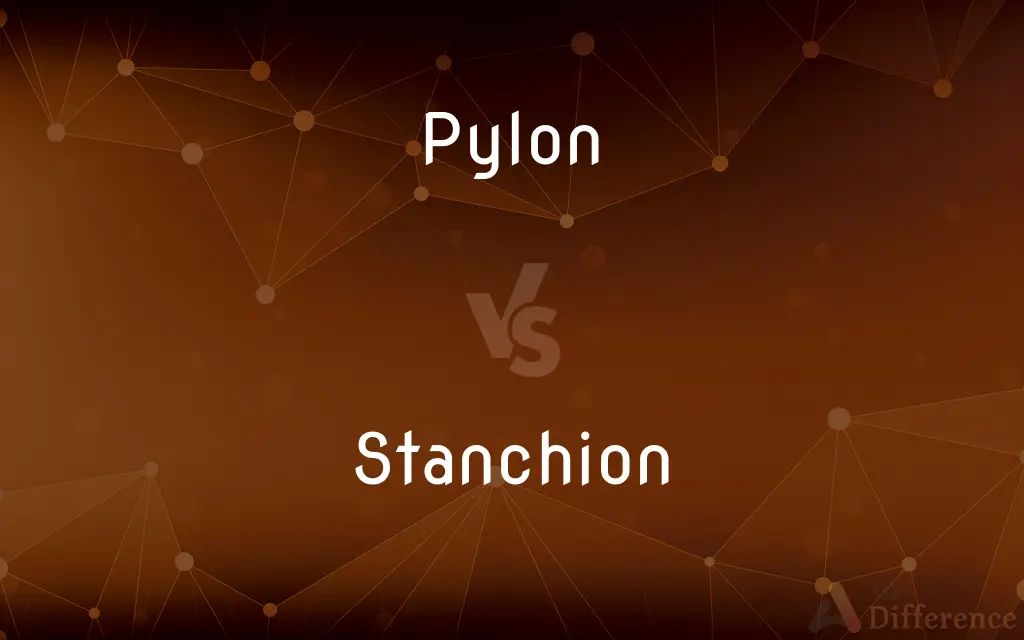Pylon vs. Stanchion — What's the Difference?
Edited by Tayyaba Rehman — By Urooj Arif — Updated on March 28, 2024
Pylon often refers to a large, vertical structure supporting electrical wires or marking gateways, while stanchion is a vertical support beam or post.

Difference Between Pylon and Stanchion
Table of Contents
ADVERTISEMENT
Key Differences
Pylons are typically large, towering structures used to support electrical cables, bridges, or serve as monuments. They are integral to infrastructure, often seen stretching across landscapes or waterways to carry power lines. Whereas stanchions are more versatile, serving as support posts or barriers in various settings, from construction sites to events, and even as railings or barriers in public places.
While pylons are primarily associated with heavy-duty support for bridges or electrical cables, highlighting their role in large-scale engineering projects, stanchions play a crucial role in crowd control, queuing systems, and temporary barriers, emphasizing their utility in organizing spaces and people.
Pylons are constructed to be permanent fixtures, engineered to withstand environmental challenges and provide stable support for long-term projects. On the other hand, stanchions are often designed to be movable or temporary, adaptable to changing needs and environments, from guiding lines in banks to securing areas at event venues.
In terms of design, pylons have a distinct appearance, usually tall and slender, made of materials like steel or concrete to ensure durability and strength. Stanchions, however, vary widely in design, from simple rope and pole barriers to heavy-duty metal posts, reflecting their wide range of uses in both indoor and outdoor settings.
The selection between a pylon and a stanchion depends on the intended use: pylons for substantial structural support and wide-span electrical transmission, and stanchions for versatile, often temporary, support and spatial organization.
ADVERTISEMENT
Comparison Chart
Primary Function
Support for electrical cables, bridges, or as monuments.
Support posts or barriers for crowd control and guidance.
Use Cases
Electrical transmission, bridge support, monuments.
Queue management, barriers, temporary supports.
Durability
Designed for permanence and to withstand environmental wear.
Often movable, adaptable, can be temporary or permanent.
Design
Tall, slender, made of steel or concrete.
Varied designs, from simple poles to heavy-duty metal posts.
Context of Use
Large-scale engineering projects, infrastructure.
Events, construction sites, public spaces for organization.
Compare with Definitions
Pylon
A tall structure used to support cables or bridges.
The new bridge's design featured elegant pylons that were visible from miles away.
Stanchion
A support post or beam used as a barrier or support.
Stanchions with velvet ropes lined the entrance to the premiere.
Pylon
Often used in electrical transmission.
Pylons across the countryside carry high-voltage lines from the power station.
Stanchion
Important for organizing spaces and managing crowds.
The use of stanchions at the ticket counters helped manage the long queues efficiently.
Pylon
Designed for durability and long-term use.
Each pylon was constructed to endure extreme weather conditions for decades.
Stanchion
Versatile in use, from crowd control to construction support.
We used stanchions to create a temporary walkway through the construction site.
Pylon
Essential in large-scale engineering and infrastructure projects.
The project's success depended on the strategic placement of pylons along the route.
Stanchion
Can be temporary or permanent, depending on the need.
Temporary stanchions were set up for the event but could be removed afterward.
Pylon
Can serve as a monumental or navigational structure.
The twin pylons at the entrance to the city became iconic landmarks.
Stanchion
Designs vary widely to suit different applications.
The museum installed decorative stanchions to guide visitors without obstructing views.
Pylon
A movable, brightly colored cone or shaft of rubber that is used to signal something to be avoided, such as a hazard or work zone on a roadway.
Stanchion
A stanchion () is a sturdy upright fixture that provides support for some other object. It can be a permanent fixture.
Pylon
(Football) A flexible, usually padded marker that stands upright at each corner of the end zone to facilitate judgments of close plays.
Stanchion
An upright pole, post, or support.
Pylon
A tower marking a turning point in a race among aircraft.
Stanchion
A framework consisting of two or more vertical bars, used to secure cattle in a stall or at a feed trough.
Pylon
A steel tower supporting high-tension wires.
Stanchion
To equip with stanchions.
Pylon
A tower or shaft supporting a wind turbine.
Stanchion
To confine (cattle) by means of stanchions.
Pylon
A structure supporting a bridge deck.
Stanchion
A vertical pole, post, or support.
Pylon
A large structure or group of structures marking an entrance or approach.
Stanchion
A framework of such posts, used to secure or confine cattle.
Pylon
A monumental gateway in the form of a pair of tapered blocks serving as the entrance to an ancient Egyptian temple.
Stanchion
To erect stanchions, or equip something with stanchions.
Pylon
A structure that attaches an aircraft engine to a plane's wing or fuselage.
Stanchion
To confine by means of stanchions, typically used for cattle.
Pylon
A gateway to the inner part of an Ancient Egyptian temple.
Stanchion
A prop or support; a piece of timber in the form of a stake or post, used for a support or stay.
Pylon
(electricity) A tower-like structure, usually one of a series, used to support high-voltage electricity cables.
Stanchion
Any upright post or beam used as a support, as for the deck, the quarter rails, awnings, etc.
Pylon
(architecture) A tall steel or concrete tower from which cables are strung.
Stanchion
A vertical bar for confining cattle in a stall.
Pylon
A lighting mast; a freestanding support for floodlights.
Stanchion
Any vertical post or rod used as a support
Pylon
(aviation) A structure used to mount engines, missiles etc., to the underside of an aircraft wing or fuselage.
Pylon
A starting derrick for an aeroplane.
Pylon
A post, tower, etc. as on an aerodrome, or flying ground, serving to bound or mark a prescribed course of flight.
Pylon
An obelisk.
Pylon
A traffic cone.
Pylon
(American football) An orange marker designating one of the four corners of the end zone in American football.
Pylon
(medicine) A rigid prosthesis for the lower leg.
Pylon
A low tower, having a truncated pyramidal form, and flanking an ancient Egyptian gateway.
Massive pylons adorned with obelisks in front.
Pylon
An Egyptian gateway to a large building (with or without flanking towers).
Pylon
A tower, commonly of steelwork, for supporting either end of a wire, as for a telegraph line, over a long span.
Pylon
Formerly, a starting derrick (the use of which is now abandoned) for an aeroplane.
Pylon
A tower for guiding pilots or marking the turning point in a race
Pylon
A large vertical steel tower supporting high-tension power lines;
Power pylons are a favorite target for terrorists
Common Curiosities
Are pylons only used for electrical transmission?
No, pylons are also used to support bridges, as navigational or monumental structures, and in other infrastructure projects.
How is a stanchion different from a pylon?
A stanchion is a support beam or post, often used for crowd control or as a barrier, more versatile and not limited to large-scale engineering projects like pylons.
Can stanchions be permanent fixtures?
Yes, stanchions can be designed to be permanent fixtures, although they are often used in temporary or movable applications.
Are all pylons tall and slender?
Most pylons are designed to be tall and slender to efficiently support structures like cables or bridges, though designs can vary based on specific needs.
Can stanchions be used for supporting structures like pylons?
While stanchions provide support and can be used in construction, they are not designed for the same level of structural support as pylons, which support bridges and electrical cables.
How do stanchions help in crowd control?
Stanchions guide people, manage queues, and restrict access to certain areas, helping organize spaces and control crowds effectively.
Do stanchions have a standard design?
No, stanchions come in various designs, from simple rope and pole barriers to heavy-duty metal posts, to suit different uses and settings.
What is a pylon?
A pylon is a large, vertical structure that supports electrical wires, bridges, or serves as a monument, often a key component in infrastructure.
What materials are pylons made of?
Pylons are typically made of steel or concrete to ensure durability and strength for supporting heavy loads over long periods.
Why might a business use stanchions?
Businesses use stanchions for practical purposes like queuing and crowd control, but also aesthetically, to complement the environment and ensure orderly movement of customers.
What maintenance does a pylon require?
Pylons require regular inspections and maintenance to ensure structural integrity, especially those exposed to harsh environmental conditions.
Can stanchions be used indoors and outdoors?
Yes, stanchions are versatile and can be used both indoors and outdoors, depending on the material and design.
What role do pylons play in bridge construction?
Pylons serve as critical support structures in bridges, often holding up the bridge deck and enabling spans over long distances.
How do the functions of pylons and stanchions overlap?
While both provide support, their functions rarely overlap; pylons are essential for structural support in large-scale projects, whereas stanchions are more about spatial organization and crowd control.
How are stanchions used in events?
At events, stanchions are used to create lines, divide spaces, and direct flow of attendees, enhancing organization and safety.
Share Your Discovery

Previous Comparison
Competition vs. Collaboration
Next Comparison
Atropine vs. HyoscyamineAuthor Spotlight
Written by
Urooj ArifUrooj is a skilled content writer at Ask Difference, known for her exceptional ability to simplify complex topics into engaging and informative content. With a passion for research and a flair for clear, concise writing, she consistently delivers articles that resonate with our diverse audience.
Edited by
Tayyaba RehmanTayyaba Rehman is a distinguished writer, currently serving as a primary contributor to askdifference.com. As a researcher in semantics and etymology, Tayyaba's passion for the complexity of languages and their distinctions has found a perfect home on the platform. Tayyaba delves into the intricacies of language, distinguishing between commonly confused words and phrases, thereby providing clarity for readers worldwide.














































